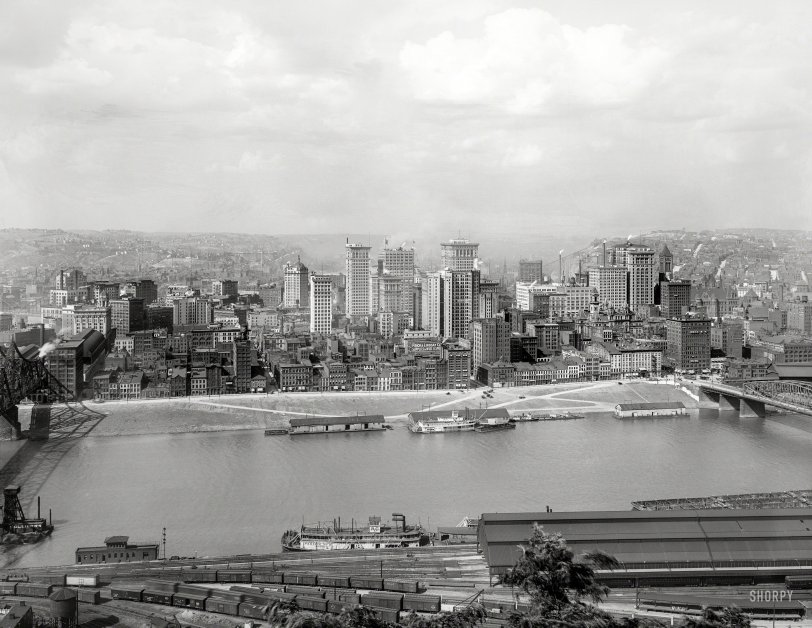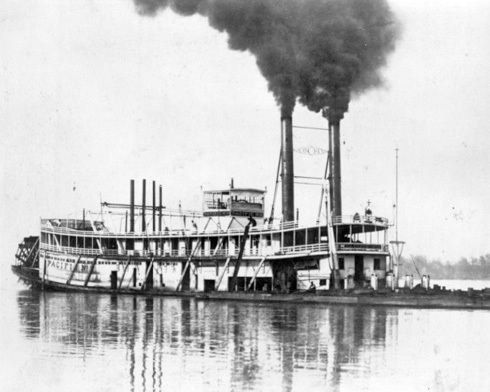


Framed or unframed, desk size to sofa size, printed by us in Arizona and Alabama since 2007. Explore now.
Shorpy is funded by you. Patreon contributors get an ad-free experience.
Learn more.

- Tough Guys
- Lost in Toyland
- And without gloves
- If I were a blindfolded time traveler
- Smoke Consumer Also Cooks
- Oh that stove!
- Possibly still there?
- What?!?
- $100 Reward
- Freeze Frame
- Texas Flyer wanted
- Just a Year Too Soon
- WWII -- Replacing men with women at the railroad crossing.
- Yes, Icing
- You kids drive me nuts!
- NOT An Easy Job
- I wonder
- Just add window boxes
- Icing Platform?
- Indiana Harbor Belt abides
- Freezing haze
- Corrections (for those who care)
- C&NW at Nelson
- Fallen Flags
- A dangerous job made worse
- Water Stop
- Passenger trains have right of way over freights?
- Coal
- Never ceases to amaze me.
- Still chuggin' (in model form)
Print Emporium
Growth Spurt: 1912

Along the Monongahela circa 1912. "A group of skyscrapers, Pittsburgh." 8x10 inch dry plate glass negative, Detroit Publishing Company. View full size.
Shove Me Timbers
Looks like the locomotive lower left edge of photo just made a shove move on the four blurry box cars. The loco and 2 attached cars are only slightly fuzzy, indicating they had just about come to a stop when the shutter opened, while the four box cars picked up speed from the shove as the shutter remained open.
Looks like one of the crew was on the ground directing the move (visible near the door of the white box car where the train was uncoupled for the shove move).
Collier is a Collier
Collier Nr4 probably is a collier, a boat for handling coal, in this particular case, vertically. We've seen on this site photos of New York Harbor with floating grain elevators, for handling smaller particles.
Collier Nr 4
Any idea what the Collier Nr 4, left side of photo, might be? It looks a lot like a coal mine headstock, but the location sort of precludes that it is a mine shaft (but anything is possible)! Perhaps a barge loader/unloader?
Thanks! (In afterthought, I realized that a mine would be a COLLIERY, a barge or ship a COLLIER).
"River Combine" "River Coal"
Pacific No. 2 was a steam powered stern wheel towboat of 570 gross and 416 net tons, with a length of 176 feet, a breadth of 32 feet, a depth/draft of 5 feet and a crew of 35.
Owned by the Pacific Coal and Towboat Company, Captains Joe and Ab Gould and later Captain W. J. Wood, Pacific No. 2 was built in Pittsburgh in 1893 using the steam engines from the former steam towboat Lioness No. 2 which was built in 1869. Pacific No. 2 continued towing until retired about 1913 and was dismantled two years later at Elizabeth, Pennsylvania. The hull was converted into a barge and in 1920 was used by Follansbee Bros. to haul cement.
In 1899, responding to economic conditions, disruptions in the coal industry, and the frequent loss of towboats and barges (often by collision with bridge piers) the Monongahela River Consolidated Coal and Coke Company was formed, absorbing the assets of most of the independent towboat companies. The amalgamated companies initialed their towboats and barges with the letters “RC” for “River Combine” or “River Coal.”
The Pacific No. 2, prior to the “RC” logo:

Wabash Bridge
On the left is the Wabash Railroad Bridge that served the small station visible across the river. Trains reached this location through a tunnel under Mt. Washington (where, undoubtedly the photographer was standing when the photograph was taken). The tunnel is now used for vehicular traffic.
It may not come as a shock to Shorpy visitors that the train station burned in 1946. The bridge was removed in 1948; in the modern view supplied by Kozel you can see one of the the still-standing ghostly piers of the bridge.
Very different skyline, but --
That's the Smithfield Street Bridge on the right. Some of the buildings below Wood Street (first street to the left of Smithfield) remain today.
























On Shorpy:
Today’s Top 5